CD127+CCR5+CD38+++ CD4+ Th1 effector cells are an early component of the primary immune response to vaccinia virus and precede development of interleukin-2+ memory CD4+ T cells
- PMID: 17005692
- PMCID: PMC1617315
- DOI: 10.1128/JVI.02670-05
CD127+CCR5+CD38+++ CD4+ Th1 effector cells are an early component of the primary immune response to vaccinia virus and precede development of interleukin-2+ memory CD4+ T cells
Abstract
The stages of development of human antigen-specific CD4+ T cells responding to viral infection and their differentiation into long-term memory cells are not well understood. The inoculation of healthy adults with vaccinia virus presents an opportunity to study these events intensively. Between days 11 and 14 postinoculation, there was a peak of proliferating CCR5+CD38+++ CD4+ effector cells which contained the cytotoxic granule marker T-cell intracellular antigen 1 and included gamma interferon (IFN-gamma)-producing vaccinia virus-specific CD4+ T cells. The majority of these initial vaccinia virus-specific CD4+ T cells were CD127+ and produced interleukin-2 (IL-2) but not CTLA-4 in response to restimulation in vitro. Between days 14 and 21, there was a switch from IFN-gamma and IL-2 coexpression to IL-2 production only, coinciding with a resting phenotype and an increased in vitro proliferation response. The early CCR5+CD38+++ vaccinia virus-specific CD4+ T cells were similar to our previous observations of human immunodeficiency virus (HIV)-specific CD4+ T cells in primary HIV type 1 (HIV-1) infection, but the vaccinia virus-specific cells expressed much more CD127 and IL-2 than we previously found in their HIV-specific counterparts. The current study provides important information on the differentiation of IL-2+ vaccinia virus-specific memory cells, allowing further study of antiviral effector CD4+ T cells in healthy adults and their dysfunction in HIV-1 infection.
Figures
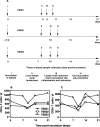
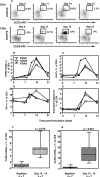
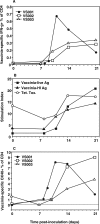
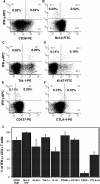
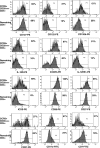


Similar articles
-
Infection of CD127+ (interleukin-7 receptor+) CD4+ cells and overexpression of CTLA-4 are linked to loss of antigen-specific CD4 T cells during primary human immunodeficiency virus type 1 infection.J Virol. 2006 Oct;80(20):10162-72. doi: 10.1128/JVI.00249-06. J Virol. 2006. PMID: 17005693 Free PMC article.
-
CD38 identifies a hypo-proliferative IL-13-secreting CD4+ T-cell subset that does not fit into existing naive and memory phenotype paradigms.Eur J Immunol. 2011 May;41(5):1298-308. doi: 10.1002/eji.201040726. Epub 2011 Apr 13. Eur J Immunol. 2011. PMID: 21469087
-
Early proliferation of CCR5(+) CD38(+++) antigen-specific CD4(+) Th1 effector cells during primary HIV-1 infection.Blood. 2005 Sep 1;106(5):1660-7. doi: 10.1182/blood-2005-01-0206. Epub 2005 May 19. Blood. 2005. PMID: 15905189
-
Human CD4+ T cell differentiation and effector function: implications for autoimmunity.Immunol Res. 1999;19(1):25-34. doi: 10.1007/BF02786474. Immunol Res. 1999. PMID: 10374693 Review.
-
Death of effector memory T cells characterizes AIDS.Front Biosci (Landmark Ed). 2009 Jan 1;14(11):4386-400. doi: 10.2741/3535. Front Biosci (Landmark Ed). 2009. PMID: 19273357 Review.
Cited by
-
Infection of CD127+ (interleukin-7 receptor+) CD4+ cells and overexpression of CTLA-4 are linked to loss of antigen-specific CD4 T cells during primary human immunodeficiency virus type 1 infection.J Virol. 2006 Oct;80(20):10162-72. doi: 10.1128/JVI.00249-06. J Virol. 2006. PMID: 17005693 Free PMC article.
-
CD73+ CD127high Long-Term Memory CD4 T Cells Are Highly Proliferative in Response to Recall Antigens and Are Early Targets in HIV-1 Infection.Int J Mol Sci. 2021 Jan 18;22(2):912. doi: 10.3390/ijms22020912. Int J Mol Sci. 2021. PMID: 33477692 Free PMC article.
-
Innate and Adaptive Immunity in Long-Term Non-Progression in HIV Disease.Front Immunol. 2013 Apr 24;4:95. doi: 10.3389/fimmu.2013.00095. eCollection 2013. Front Immunol. 2013. PMID: 23630526 Free PMC article.
-
Partial efficacy of a VSV-SIV/MVA-SIV vaccine regimen against oral SIV challenge in infant macaques.Vaccine. 2011 Apr 12;29(17):3124-37. doi: 10.1016/j.vaccine.2011.02.051. Epub 2011 Mar 4. Vaccine. 2011. PMID: 21377510 Free PMC article.
-
Impaired innate, humoral, and cellular immunity despite a take in smallpox vaccine recipients.Vaccine. 2016 Jun 14;34(28):3283-90. doi: 10.1016/j.vaccine.2016.05.005. Epub 2016 May 11. Vaccine. 2016. PMID: 27177944 Free PMC article.
References
-
- Appay, V., J. J. Zaunders, L. Papagno, J. Sutton, A. Jaramillo, A. Waters, P. Easterbrook, P. Grey, D. Smith, A. J. McMichael, D. A. Cooper, S. L. Rowland-Jones, and A. D. Kelleher. 2002. Characterization of CD4+ CTLs ex vivo. J. Immunol. 168:5954-5958. - PubMed
-
- Bertram, E. M., W. Dawicki, and T. H. Watts. 2004. Role of T cell costimulation in anti-viral immunity. Semin. Immunol. 16:185-196. - PubMed
-
- Bertram, E. M., A. Tafuri, A. Shahinian, V. S. Chan, L. Hunziker, M. Recher, P. S. Ohashi, T. W. Mak, and T. H. Watts. 2002. Role of ICOS versus CD28 in antiviral immunity. Eur. J. Immunol. 32:3376-3385. - PubMed
-
- Bossi, G., and G. M. Griffiths. 2005. CTL secretory lysosomes: biogenesis and secretion of a harmful organelle. Semin. Immunol. 17:87-94. - PubMed
Publication types
MeSH terms
Substances
LinkOut - more resources
Full Text Sources
Research Materials
Miscellaneous

